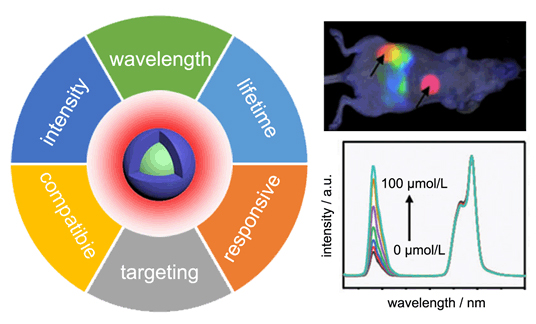摘要/Abstract

稀土纳米晶具有丰富的激发和发射波长,良好的化学和光稳定性、大Stokes位移等特点.近年来,稀土纳米晶在生物活体成像与传感领域的应用研究取得了迅速进展.通过纳米尺度的材料设计与合成,可以对稀土纳米晶的荧光效率、波长、寿命等光学性质,以及生物相容性、靶向性、响应性等生化性质进行精细调控,使其更好地适应于活体深组织的成像与分析.先概述活体荧光成像的技术特点与要求,然后介绍稀土纳米晶的一般组成、光学性质和荧光机理,随后详细讨论对稀土纳米晶光学和生化性质进行调控的方法,着重展示这些材料的设计和修饰在生物成像与传感领域的一些最新应用.通过总结最近的研究成果,期望能够为下一步的研究提供一些参考思路,以推进基于稀土纳米晶的生物成像与传感技术的临床转化和应用.
关键词: 稀土纳米晶, 生物成像, 生物传感, 近红外, 荧光
In vivo imaging and sensing play a critical role in modern biological and medical research. Compared with other techniques such as computed tomography (CT), positron emission tomography (PET) and nuclear magnetic resonance (NMR), fluorescence imaging and analysis are featured by fast feedback, high sensitivity, and high spatiotemporal resolution. Especially, the application of near infrared (NIR) light as both excitation and emission signals provides increased tissue penetration and improved imaging quality and sensitivity due to reduced light scattering and auto-fluorescence. Among various materials investigated for in vivo imaging and bio-sensing, lanthanide-based nanocrystals display rich excitation/emission wavelengths in the NIR range, good photo and chemical stability, large Stokes shifts. In recent years, the research on lanthanide-based nanocrystals for in vivo imaging and sensing has seen rapid progress. Through nanoscale material design and synthesis, it is possible to fine tune the optical properties of lanthanide-based nanocrystals. By properly choosing different lanthanide ions as activators and sensitizers, multiple excitation/emission wavelengths can be obtained. The careful design of core-shell structure of nanocrystals enables improved fluorescence efficiency and tailorable fluorescence life time through controlled energy transfer. On the other side, the surface of lanthanide-based nanocrystals can be modified through coating, absorption or ligand exchange to enhance the biocompatibility, targeting capability, and bio-responsiveness. Taking advantage of this high flexibility and versatility, there are great opportunities for these lanthanide-based nanocrystals in various in vivo imaging and sensing applications. This review first outlines the general technique requirements for in vivo imaging and sensing. Then, the composition, synthesis and basic properties of lanthanide-based nanocrystals are briefly introduced. Subsequently, the routes for tailoring the optical and biochemical properties of lanthanide-based nanocrystals are discussed in detail, with an emphasis on the material designs and surface modifications for in vivo imaging and analysis. It is expected that this work will inspire new ideas for accelerating the clinic translation of rare earth nanocrystals-based imaging and sensing techniques.
Key words: rare earth nanocrystals, bio-imaging, bio-sensing, near infrared, fluorescence
PDF全文下载地址:
点我下载PDF
